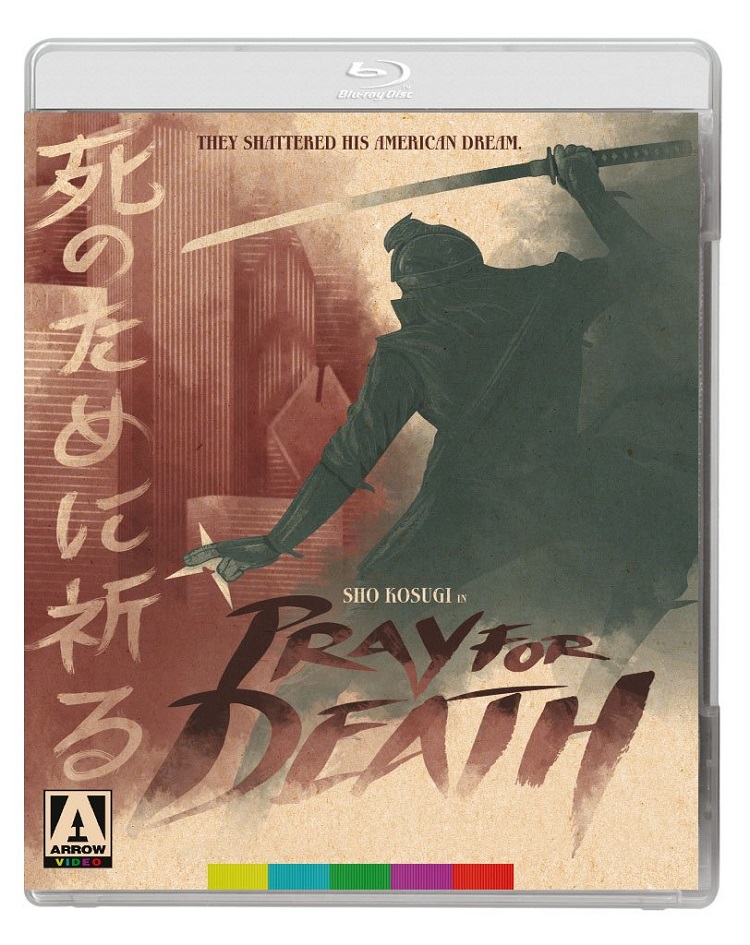
When I was a kid, one of the local television stations used to run a show called Kung Fu Theater late at night on the weekends. My cousins and I loved it. I have many fond memories of staying over at my grandmother’s house with them and staying up late (well, late for a nine-year-old boy which probably means about 10:30-11) and watching all those old chopsocky films. Even then we knew the films weren’t particularly good and during the boring talking parts, we’d sit around doing whatever nine-year-old boys do when they are spending the night at their grandmothers (probably play games and draw pictures of fast cars and monster trucks). But when the action started, we’d put everything down and watch intently. Then we’d spend the next day reenacting all the moves.
In the years gone by, I’ve not watched a whole lot of kung fu cinema but I still have a great nostalgic love for those films, so when I found a copy of Pray for Death in the mail I was overjoyed. Unfortunately as an adult and a critic, I now have to sit through all those boring talking parts (though I still draw the monster trucks) and boy, does Pray for Death have a lot of them.
For a movie that is part of the grand ’80s tradition of ninja movies, whose main protagonist is a ninja and whose main actor is known for nothing but ninja movies, this film is really light on ninja action. It’s not until the last twenty minutes that we get to see any ninjas at all.
That’s like turning on a porno only to find that when the hunky TV repair man comes over instead of immediately forgetting his work and sexing the hot house wife he actually repairs the damn television. Then he repairs the air conditioner, sits down for a long chat, eats dinner, then watches a few shows on that TV only to finally – after an hour and ten minutes remembers to sex it up.
The plot, such as it is, involves a gentle business man Akira (the legendary Sho Kosugi) living in Tokyo with his Japanese-American wife and two children. The wife desperately wants to move back to the USA to teach their kids about their American heritage, but Akira feels America is nothing but a cesspool of crime and violence. But when the opportunity arises to move to Houston and run a restaurant, they take it.
Little did they know the former owner of the restaurant was in cahoots with a band of crooked cops who used the restaurant to store their stolen goods, including a priceless necklace. One of the cops decides to keep the necklace for himself, unleashing the wrath of the local syndicate. Of course, the bad guys suspect Akira. Of course, they kidnap his children and do egregious harm to his wife which, unleashes the hidden ninja inside of him.
Though there is a bit of action scattered throughout, most of the film is a bit of a slog as they set up the plot and try to give the characters a little development. Akira repeatedly reminds his children that they are on their own, that ninjas do not really exist and will not come to save them. It is only in the last twenty minutes, after the main bad guy has raped and killed his wife that he reveals that yes, Virginia, there really are ninjas and I am one of them.
Ah, but those last twenty minutes make the entire film totally worth it. Akira dons the most ’80s ninja suit ever with shiny metal protections for his legs and arms, chain mail for the chest, and a retractable face mask complete with Chinese star on top. The suit is donned, a preparation montage is played, and the asses, finally, start getting kicked.
He first tackles a dozen or so generic bad guys at their lair, unleashing death by arrow, by sword, and by ninja stars. One of the bosses gets it with this crazy multi-prong knife thing through the throat that hangs him to a door. Our main baddie nearly escapes before trying to run over Akira in his truck, leading to some fantastic truck-jumping flips and a nice bit of being dragged beneath the vehicle. They wind up in a warehouse full of creepy mannequins, lots of stair,s and a room equipped with a chainsaw and one of those giant log-splitting saws. I think we all know how that will end.
Arrow has given Pray for Death a remarkable transfer. The video looks quite amazing for a b-grade ninja movie from the ’80s. The colors are, well not exactly bright as this is the sort of film that doesn’t spend a lot of money on cinematography, but well defined. It’s been cleaned up well and mostly looks better than one could ever hope for. However, when the scenes are shot at night or in a dark room, the grain is very noticeable and I caught more than a few lines running through the screen. Being the type of film this is, there are a few scenes in which the lighting doesn’t match from cut to cut. One moment there will be a medium shot in bright light followed by a close up in the dark and it is in these moments that the grain is rather distracting.
Extras include several trailer for other Kosugi ninja movies, a couple of interviews with Kosugi (one recent, the other older), and footage from his ninja demonstration from the Pray for Death premiere.
If you are looking for lots of ninja action, Pray for Death can be a bit disappointing. If you’ve got a thing for cheese-ball ’80s action flicks, you’ll find plenty to love here. For the rest of you just skip to the last twenty minutes and feast on a beautifully rendered bit of ninja glory.